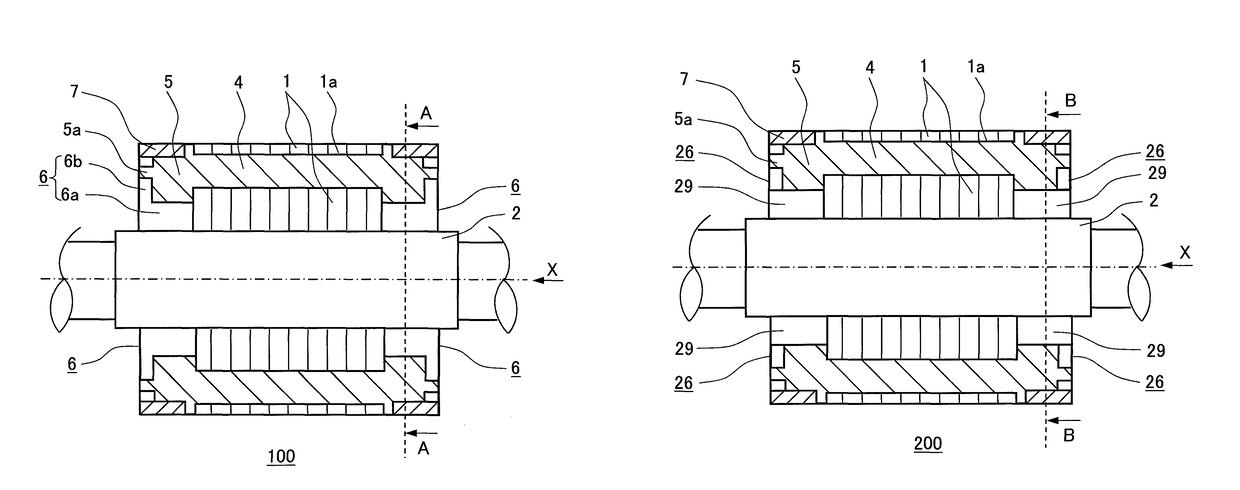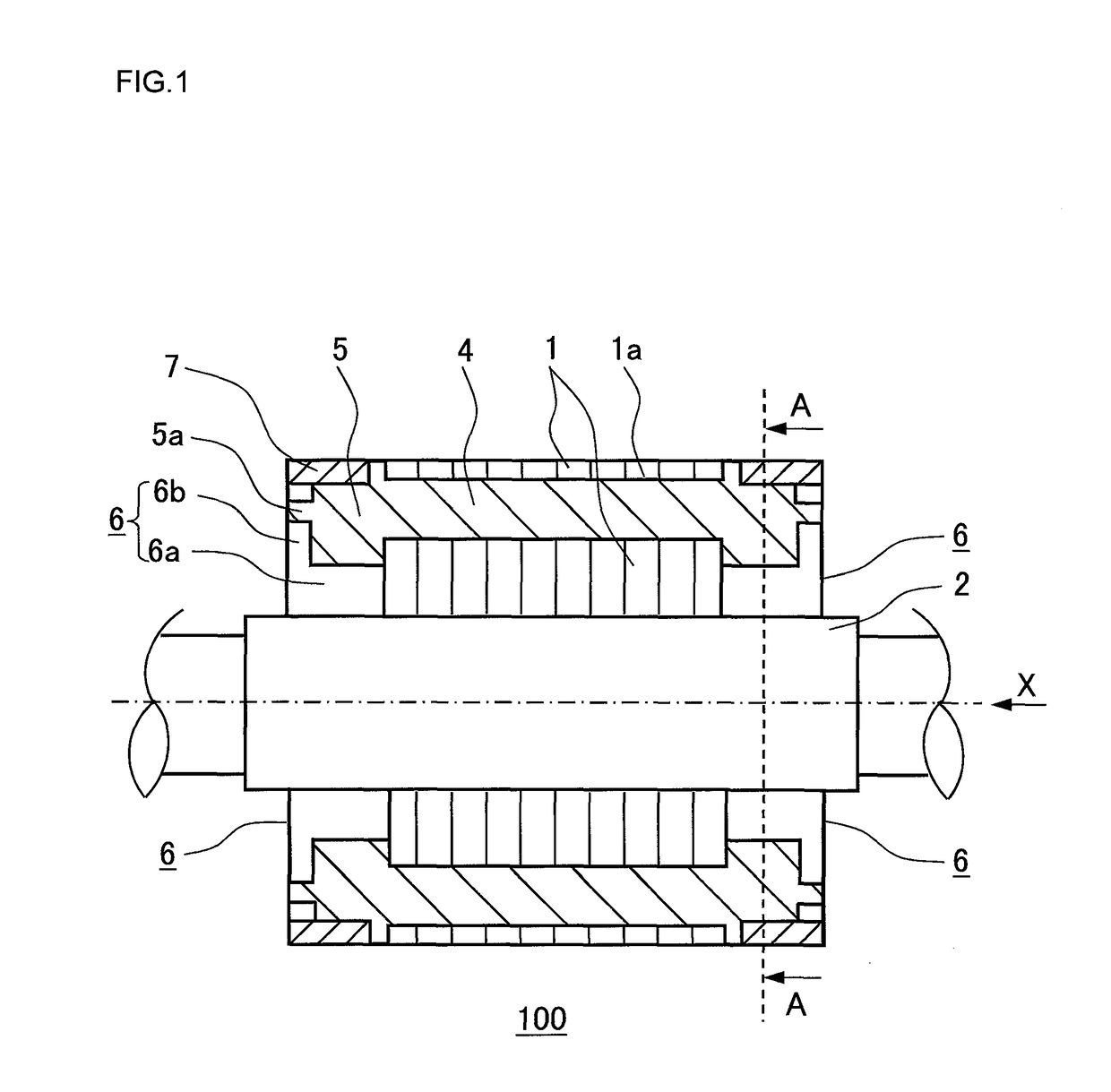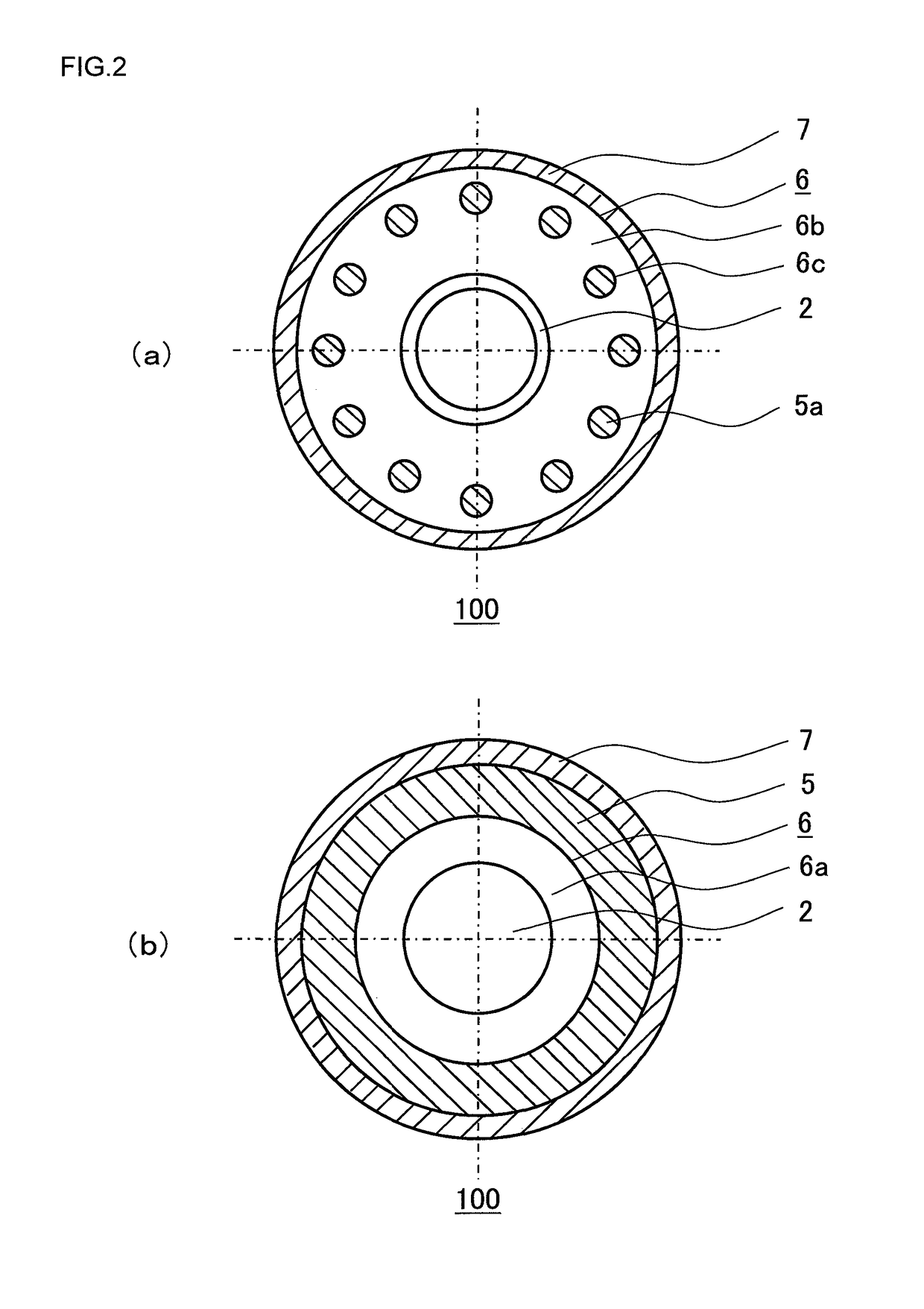Squirrel-cage motor rotor and squirrel-cage motor
a squirrel-cage motor and rotor technology, applied in the direction of dynamo-electric machines, electrical apparatus, magnetic circuit shapes/forms/construction, etc., can solve the problems of repeated stress on the short-circuit ring and metal fatigue, and achieve the prevention of short-circuit ring breakage due to metal fatigue, the effect of preventing the detachment or displacement of the reinforcement cover
- Summary
- Abstract
- Description
- Claims
- Application Information
AI Technical Summary
Benefits of technology
Problems solved by technology
Method used
Image
Examples
embodiment 1
[0042]FIG. 1 is a schematic sectional view of a squirrel-cage motor rotor according to embodiment 1 of the present invention.
[0043]FIG. 2 is a schematic plan view (a) as seen from the direction indicated by an arrow X and a schematic view (b) of an A-A cross section, of the squirrel-cage motor rotor according to embodiment 1 of the present invention shown in FIG. 1.
[0044]FIG. 2 shows a plan view and a sectional view of the entirety of a squirrel-cage motor rotor 100 of the present embodiment.
[0045]As shown in FIG. 1 and FIG. 2, the squirrel-cage motor rotor 100 of the present embodiment includes a cylindrical rotor core 1 formed by stacking electromagnetic steel sheets, conductor bars 4 respectively filling a plurality of slot holes 1a which penetrate the rotor core 1 in the axial direction and are arranged at regular intervals along the circumferential direction of the rotor core 1, short-circuit rings 5 connected to ends of the conductor bars 4, reinforcement covers 6 contacting w...
embodiment 2
[0083]FIG. 5 is a schematic sectional view of a squirrel-cage motor rotor according to embodiment 2 of the present invention.
[0084]FIG. 6 is a schematic plan view (a) as seen from the direction indicated by an arrow X and a schematic view (b) of a B-B cross section, of the squirrel-cage motor rotor according to embodiment 2 of the present invention shown in FIG. 5.
[0085]FIG. 6 shows a plan view and a sectional view of the entirety of a squirrel-cage motor rotor 200 of the present embodiment.
[0086]As shown in FIG. 5 and FIG. 6, the squirrel-cage motor rotor 200 of the present embodiment includes a cylindrical rotor core 1 formed by stacking electromagnetic steel sheets, conductor bars 4 respectively filling a plurality of slot holes 1a which penetrate the rotor core 1 in the axial direction and are arranged at regular intervals along the circumferential direction of the rotor core 1, short-circuit rings 5 connected to ends of the conductor bars 4, reinforcement covers 26 contacting w...
embodiment 3
[0106]FIG. 7 is a schematic sectional view of a squirrel-cage motor rotor according to embodiment 3 of the present invention.
[0107]FIG. 8 is a schematic plan view (a) as seen from the direction indicated by an arrow X and a schematic view (b) of a C-C cross section, of the squirrel-cage motor rotor according to embodiment 3 of the present invention shown in FIG. 7.
[0108]FIG. 8 shows a plan view and a sectional view of the entirety of a squirrel-cage motor rotor 300 of the present embodiment.
[0109]As shown in FIG. 7 and FIG. 8, the squirrel-cage motor rotor 300 of the present embodiment includes a cylindrical rotor core 1 formed by stacking electromagnetic steel sheets, conductor bars 4 respectively filling a plurality of slot holes 1a which penetrate the rotor core 1 in the axial direction and are arranged at regular intervals along the circumferential direction of the rotor core 1, short-circuit rings 5 connected to ends of the conductor bars 4, reinforcement covers 36 contacting w...
PUM
 Login to View More
Login to View More Abstract
Description
Claims
Application Information
 Login to View More
Login to View More - R&D
- Intellectual Property
- Life Sciences
- Materials
- Tech Scout
- Unparalleled Data Quality
- Higher Quality Content
- 60% Fewer Hallucinations
Browse by: Latest US Patents, China's latest patents, Technical Efficacy Thesaurus, Application Domain, Technology Topic, Popular Technical Reports.
© 2025 PatSnap. All rights reserved.Legal|Privacy policy|Modern Slavery Act Transparency Statement|Sitemap|About US| Contact US: help@patsnap.com



